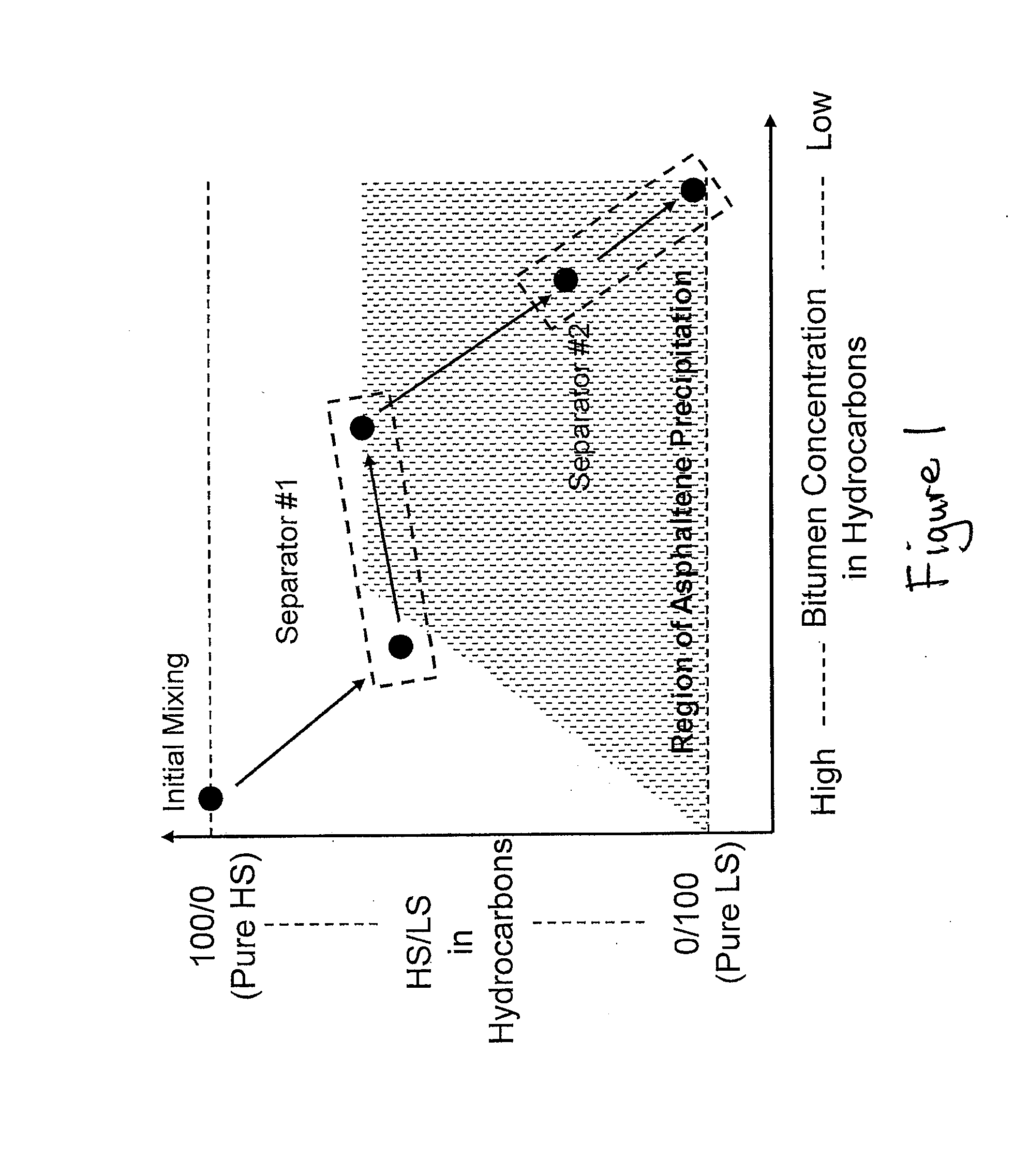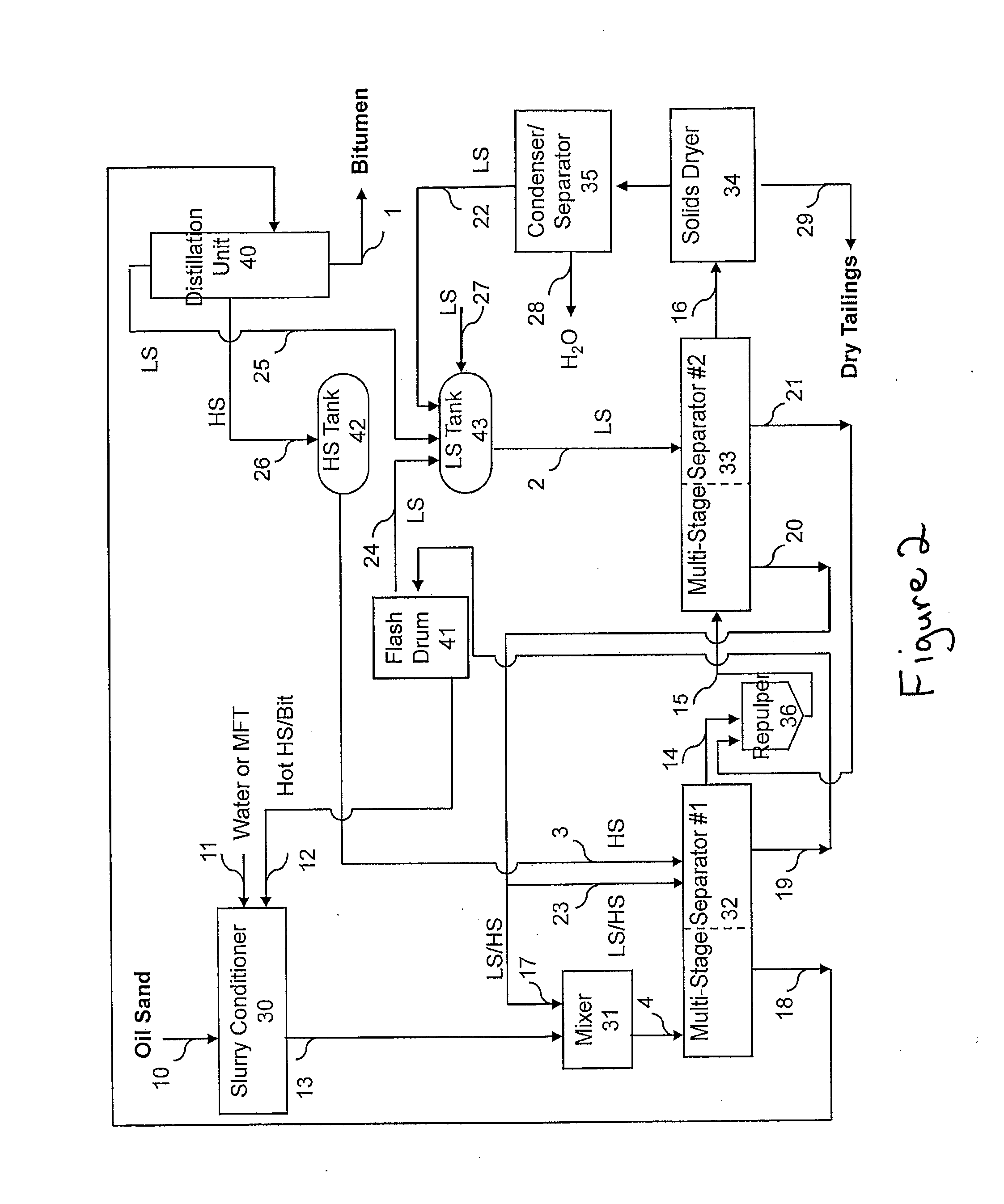Extraction of oil sand bitumen with two solvents
a solvent and oil sand technology, applied in the direction of hydrocarbon oil treatment, sustainable manufacturing/processing, climate sustainability, etc., to achieve the effect of easy recovery and minimal asphaltene precipitation
- Summary
- Abstract
- Description
- Claims
- Application Information
AI Technical Summary
Benefits of technology
Problems solved by technology
Method used
Image
Examples
example 1
[0069]A vacuum filtration test was performed using an oil sand sample containing 8.5% bitumen, 4.6% water and 86.6% solids. The fines (less than 44 μm) content was 40% in solids. This oil sand sample had been previously tested in a water-based extraction pilot and yielded 0% bitumen recovery. The filter area was 11 cm2 and the filter opening was 180 μm. The filter cake thickness was 5 cm. The vacuum was around −0.7 bar. The filtration temperature was 50° C. The boiling range of the virgin light gas oil (HS) used was 177-424° C. The light solvent (LS) was n-heptane. The filtration rates are shown in Table 1.
TABLE 1Bitumen conc.AverageTestin hydrocarbonsMass ratiofiltrate flowno.(wt %)of HS / LSrate* (L / m2 s)129.7∞ (no LS)0.13234.6 3 (75 / 25)0.10334.61.5 (60 / 40)0.31*These rates are for comparative purpose only and are increased in later experiments with better conditions in the slurry conditioning step.
[0070]Table 1 shows an example of the filtration performance in the first stage separ...
example 2
[0071]1500 g of two different types of problem oil sand samples were used in the tests. Both were lean oil sands with fines contents around 49% in solids. The oil sand was mixed with 1 wt % water and a bitumen solution in HS in a tumbler to form a dense slurry at 55° C. A LS sample (n-heptane+methylcyclohexane) was added to the dense slurry to make HS / LS around 1.5. The diluted slurry was filtered on a Buckner-type filter of 113 cm2 with a filter cake thickness of 8 cm. The vacuum was −0.6 bar. The filter temperature was kept around 50° C. A HS / LS mixture was then used to rinse the cake. The rinsed cake was repulped with the same LS sample used above in an agitated vessel. The slurry was transferred back to the filter for filtration and one last rinse with the same LS sample used above. The filter used for the first two stages of filtration prior to repulping is called “Filter #1”. The same filter used for the last two stages of filtration after repulping is called “Filter #2”. The ...
example 3
[0073]Spent filter cakes of 5 cm in thickness containing approximately 7 wt % heptane and 4 wt % water were stripped with argon at 95° C. Stripping was stopped at various moisture contents in solids. The residual heptane concentrations in solids are shown in Table 3.
TABLE 3Water conc. in solidsHeptane conc. in solidsTest no.(wt %)(mg / kg)11.3249620.5616330.1929
This example showed that the moisture content in packed spent solids must be below 0.5 wt % to achieve the light solvent concentration lower than 160 mg / kg of solids based on data interpolation. The result indicates that the light solvent recovery in the process can be greater than 99%.
PUM
| Property | Measurement | Unit |
|---|---|---|
| flash point | aaaaa | aaaaa |
| boiling points | aaaaa | aaaaa |
| temperature | aaaaa | aaaaa |
Abstract
Description
Claims
Application Information
 Login to View More
Login to View More - R&D
- Intellectual Property
- Life Sciences
- Materials
- Tech Scout
- Unparalleled Data Quality
- Higher Quality Content
- 60% Fewer Hallucinations
Browse by: Latest US Patents, China's latest patents, Technical Efficacy Thesaurus, Application Domain, Technology Topic, Popular Technical Reports.
© 2025 PatSnap. All rights reserved.Legal|Privacy policy|Modern Slavery Act Transparency Statement|Sitemap|About US| Contact US: help@patsnap.com



